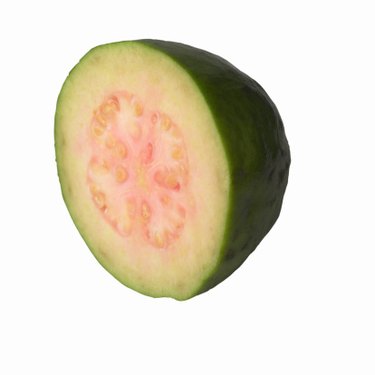Things You'll Need
Knife
Cutting board

Guava fruit comes from guava plants, tropical shrubs native to Mexico, Central America and northern regions of South America. There are nearly 100 different varieties of guava plants that produce fruit in various shapes, shades, sizes and flavors. Today, guava fruits are cultivated and bought in all parts of the world. Their flavors range from very sweet to sour, depending on ripeness. As they ripen, the fruits of the guava plant will change from a bright green to a red, yellow or darker green. The fruits are at their most flavorful when fully ripened, but they can become spoiled and rotten shortly after. Use a little background knowledge and your powers of perception to determine whether a guava fruit has spoiled.
Step 1
Grab guava fruit in your hand, and squeeze it lightly. If the skin of the fruit tears, easily collapses or has rotted away, chances are the guava has spoiled.
Video of the Day
Step 2
Inspect the guava fruit with your eyes. If there are ulcers, rotted areas or moldy spots, the guava has spoiled.
Step 3
Sniff the guava fruit. It should give off a sweet, lemony scent. If it smells rotten or aversive, it is most likely spoiled.
Step 4
Cut the guava fruit on a cutting board with a knife. If the inside appears brown or black, the fruit has spoiled.
Tip
Store guavas in your refrigerator. If left at room temperature for more than a few days, they will likely spoil.
Video of the Day